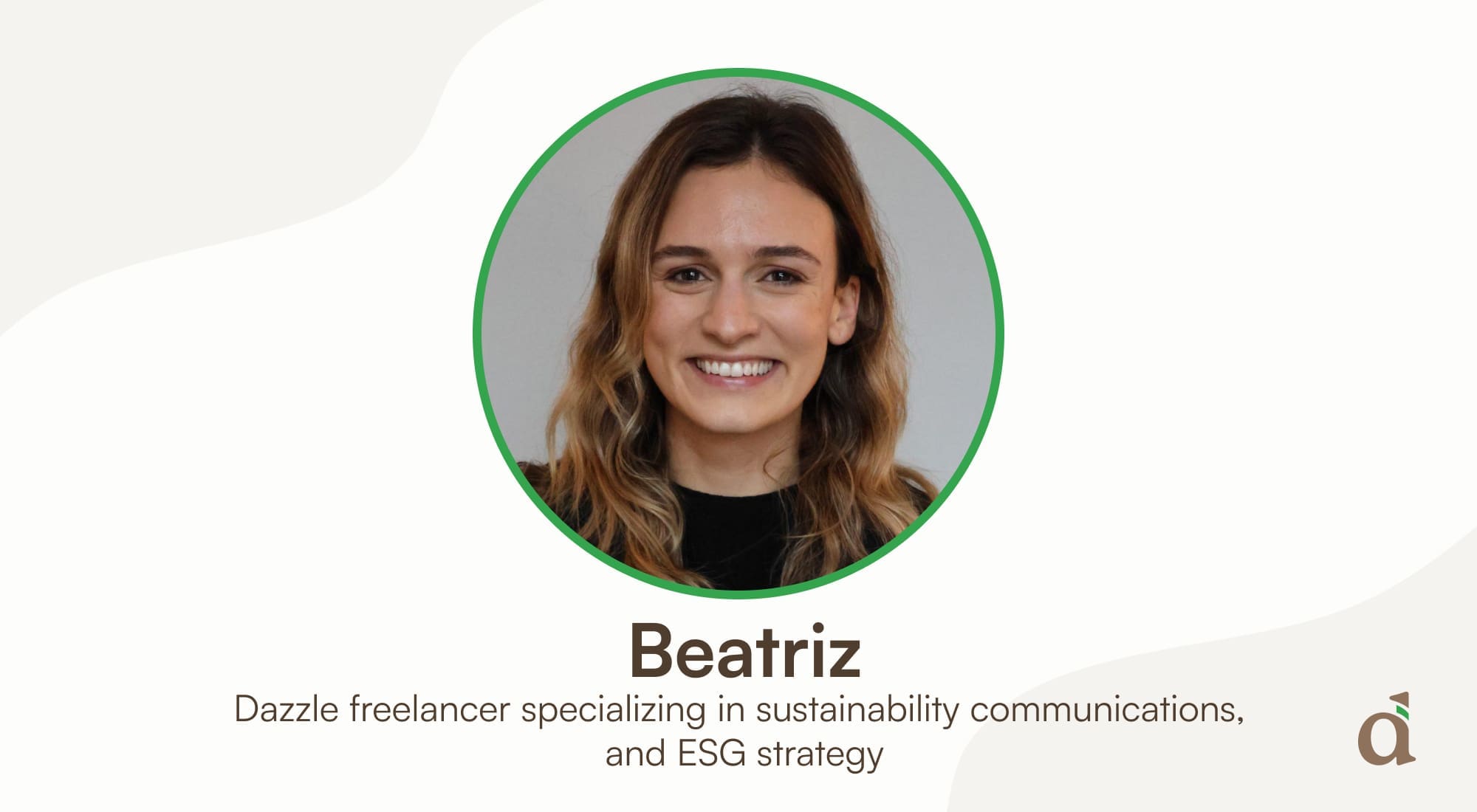Get your sustainability communications on point, and you can all but guarantee that your sustainability efforts will pay maximum dividends. All the right people will see and respond to all the good things you’re doing.
This should lead to well-earned rewards like boosted brand image, improved customer loyalty, brand new eco-conscious customers, and increased investment.
But how do you make sure your sustainability communications are on point? Well, there are many key things to consider, including avoiding greenwashing, telling an effective sustainability story, and communicating through appropriate channels.
Even when you do all of that though, it is only by constantly measuring and optimizing your communication success that you can increase its effectiveness moving forward.
(You should never see sustainability communications as a ‘one-off’ campaign. This is an ongoing process, and by measuring and optimizing, you can soon become a master at it!)
To help you on your journey toward mastery, below we’ve shared our best advice for how to measure and optimize the success of your sustainability communications.
Success’ is different for everyone though isn’t it? Okay, let’s start there.
First, what does success look like for you?
Before you can optimize your communications for success, you need to first define what that success should look like.
To do this, it’s important to set clear objectives for all of your communication efforts. Do you want to increase brand awareness? Improve employee engagement? Attract new forward-thinking investors?
By clarifying the purpose of your sustainability communications from the beginning, you will be well-positioned to adjust your messages toward fulfilling that purpose over time.

Measuring sustainability communication success
Maybe you won’t ever need to make any adjustments and you’ll just get everything perfect first time around? — We hate to break it to you, but that is unlikely. Not to worry though! This is where measurement comes in. And it’s loads of fun, we promise.
Metrics and tools for measurement
Quantitative metrics
First things first, let’s look at the hard data. By using quantitative metrics like the ones below, you can develop a clear, data-driven picture of your communication performance.
- Web analytics:
Starting with your website-based content, an effective way to gauge performance is to look at metrics like page views, bounce rates, and the time users spend on each page.
If your page views are high, it means that your content is enticing enough initially to draw people in. But if the bounce rate is also high — this is the percentage of visitors who move away from your site after viewing only one page — you definitely still need to make some tweaks. If you find that users are spending a lot of time on each page and visiting multiple pages, you know you’re doing something right!
And of course, high download rates of reports and resources are a solid indicator that your audience is responsive to the content.
- Engagement metrics:
Over on social media, we’re probably all well familiar with the metrics used to measure success. Likes, shares, comments, and mentions are what you need to be measuring here.
Lots of likes is a positive indicator of course. But make sure to pay attention to what people are saying in the comments, mentions, and share posts. People don’t always mention things for positive reasons.
- Conversion rates:
If your communications include calls-to-action, such as encouraging readers to sign up for a sustainability newsletter for example, you’ve got to be measuring those conversion rates!
This will let you know how effective each message is at moving people from passive observers to active participants.
Qualitative metrics
While quantitative data gives you the numbers, qualitative metrics can provide ‘the why’ behind those numbers. Below are some ways you can try to understand why people are responding the way they are.
- Sentiment analysis:
If you want to refine and improve your sustainability messages as you progress, you’ll need to understand how your sustainability efforts are being perceived. For this, you can conduct sentiment analysis, which involves examining feedback, reviews, or social media discussions to gauge whether people view your initiatives positively, negatively, or neutrally.
Beyond just mere numbers and data, this can give you deeper insight into stakeholder perception. Helping you to adjust your tone, focus, or approach to better resonate with your audience.
- Media coverage:
Speaking of stakeholder perception, this can be significantly influenced by the way your sustainability initiatives are covered in the media. So assessing the frequency at which your sustainability credentials are mentioned in the media, and analyzing the tone of coverage, can help determine if your messaging aligns with your goals.
- Surveys:
They may sound a little old-school, but surveys can be very valuable. They offer a direct way to gauge how your audience perceives your sustainability efforts.
Customer surveys for example can uncover insights into how well your messaging aligns with their values. While employee surveys measure internal buy-in and understanding of sustainability goals. Focus groups, and interviews also offer traditional ways to gather direct feedback from key stakeholders.
Sometimes, old-school is the way to go.
- Stakeholder testimonials:
When employees, customers, or partners leave you testimonials or reviews, look at them closely! These kinds of personal stories or quotes can reveal a lot about how your sustainability efforts are impacting individuals and communities.
Applying these insights to future sustainability messages can add a deeper layer of authenticity and relatability.
Building a measurement framework
To really ensure that your sustainability communication efforts stay aligned with your goals, it is important to build a solid measurement framework that incorporates the metrics discussed above where appropriate.
By defining clear KPIs, choosing appropriate tools, and setting benchmarks, such a framework will allow you to consistently track progress and measure impact.
- Identify KPIs:
As we already mentioned, before engaging in sustainability communications, it is crucial that you first clearly define your objectives. This should involve identifying relevant key performance indicators (KPIs).
Increasing website traffic to your sustainability pages, improving social media engagement, or achieving more positive media coverage are a few common examples here.
By setting clear and measurable communication KPIs from the outset, you’ll be putting a framework in place for evaluating your strategy’s effectiveness, and identifying opportunities for improvement.
- Choose tools:
To actually do the evaluating, you won’t just be using your eyes and ears; you are going to need some fancy tools! Tools that track your performance and provide accurate and actionable insights.
Platforms like Google Analytics for example, can be used to measure website traffic, user behavior, and conversion rates. For social media, dashboards such as Hootsuite can track metrics like engagement, reach, and sentiment. Or to gather direct feedback, you can use platforms like SurveyMonkey to efficiently survey employees, customers, or other stakeholders.
Combine these kinds of tools into a cohesive and comprehensive tracking system, and you can gather all the insights you need to optimize your communications moving forward.
- Set benchmarks:
You’ve defined your objectives, you have all the tools in place to track your progress, it must be time to click the ‘implement sustainability communications’ button by now, surely!?
Don’t worry, you’re nearly there, but first, please don’t forget to establish your baseline metrics to create a reference point for future evaluation.
What exactly are we talking about here? Well as an example, before you put any communications live, you should make a record of current audience engagement levels/website traffic/report downloads, or whatever metrics relate to your objectives. These current numbers will form the benchmark that you measure your progress against.
And as well as tracking improvements over time, this baseline data will also allow you to identify areas that need additional focus.
(Additional focus is an idea you better get used to, because now that the measuring is done, it is time to think about optimization!)

Optimizing sustainability communications
Your sustainability communications have been live and working hard for a while now. Some of your efforts are working, others seem to be falling flat. But that’s perfectly okay! You’ve been measuring your KPIs all this time and you have all the insights you need to refine your approach, and ensure your messages drive meaningful results.
Optimization is where the real fun begins, and there are several things to consider here.
Using data to refine messaging
With the information you have gathered about engagement rates, conversion rates, sentiment analysis, or whatever is most relevant to your goals, you should be able to identify which formats and topics drive the most interest.
With these insights, you can determine what your audience prefers, and tailor future messages to those preferences. For example, if video content seems to drive more engagement than text posts, it’s probably best to focus more on creating videos in future. And you can also look at which sustainability topics have sparked the most interaction so far, and create follow-up content around those topics.
(Maybe for your next round of content, you can focus on some of the topics that drove initial interest, but take a sustainability storytelling approach. This would involve sharing relatable stories around those topics, which show how your initiatives impact people or communities. This is usually always a good way to make your messages more engaging and memorable).
Optimize communication channels
There isn’t just one place to communicate sustainability you know? Like some sort of one-size-fits-all sustainability communication arena! As fun as that does sound, of course there are numerous communication channels you can use to get your sustainability message across.
To maximize impact, you should assess which channels are most effective for reaching and engaging your audience. Evaluate performance across different social media platforms, email newsletters, blog articles, or any relevant channels, to identify where your message gains the most traction.
Then moving forward, you can focus more attention on the high-performing channels.
Leverage A/B testing
A/B testing is a very useful method for optimizing sustainability communications, or any type of communications for that matter.
To leverage this method, take one of your potential sustainability messages, such as a social post, and create two variations of it. In each variation, a single element of your post — such as the headline, the visuals, or your call-to-action — should be different.
(An example here could be creating the same post but with different imagery. One variation might have an image depicting a product surrounded by nature, the other might have a picture of people using the product).
Then, put both variations live to similar audiences for the same amount of time, and you can analyze which one performs better. If one version achieves significantly better results, you’ll know to apply similar approaches to future content.
Incorporate stakeholder feedback
Whether it’s from surveys, focus groups, interviews, or testimonials and reviews, direct stakeholder feedback is an invaluable resource for improving your sustainability communications. You should always be looking to use this feedback to identify areas for enhancement.
For example, maybe your survey results indicate that employees find your sustainability reports too complex. Sounds like a perfect opportunity to create simplified summaries, or maybe some visual infographics that depict the report’s main points. Or what if customers indicate that they want to know more about your sustainability initiatives and less about your products? Well then of course, you can refine future messages to focus in that direction.
Regularly incorporate the direct feedback you receive from stakeholders, and your communications will remain relevant, transparent, and aligned with stakeholder expectations.
This is a journey, not a one-time task!
And we mean regularly!
We cannot stress enough that you should never see measuring and optimizing as a one-time task. This is something that should be an ongoing process — along with your sustainability communication efforts.
Ultimately, the goal should be to embed this process into your company culture, so that it becomes second nature. If you can do this, over time, we have no doubt that you will reach the very peak of your industry when it comes to sustainability communication.
To get started though, how about just identifying one key area to measure and optimize? Once you taste the success that will bring, we know you’ll become addicted to the process in no time!

Measure and optimize the right way with Dazzle
To help you get addicted, we would recommend bringing a temporary specialist on board; a sustainability communication optimization expert for example. (Try saying that quickly ten times in a row!).
This way you can quickly learn how to measure and optimize properly, ensuring that your efforts achieve maximum results.
If you’re not sure where you might find such an expert, don’t stress, because Dazzle has got your back!
Through the Dazzle platform, we have assembled a community of the world’s best sustainability freelancers. And this includes several sustainability communication experts.
Quality and a proven track record is guaranteed with Dazzle, as all of our freelancers are extensively pre-screened. While the process is also very flexible, because you can choose to work with our freelancers on a project-based, on-demand, or interim basis.
If you contact us today, we can send you a range of expert profiles within hours, allowing you to find the perfect fit with ease.
From there, it won’t be long before your competitors are trying to measure how far ahead your sustainability communications are!
(Feel free to check out our ultimate sustainability communications guide to find out everything you need to know!)





